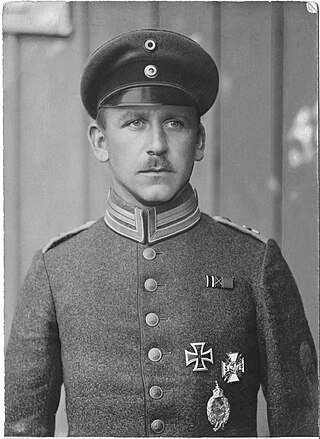Related Research Articles
Leutnant Hermann Becker, was a World War I German flying ace credited with 23 victories.
Leutnant Kurt Hetze was a World War I flying ace credited with five aerial victories.
LeutnantWilhelm Leusch was a German World War I flying ace credited with five aerial victories.
Leutnant Hans-Georg August von der Osten began his career as a World War I flying ace credited with five aerial victories. He later rose to command of all Luftwaffe bases in Germany, during World War II.
LeutnantTheodor Rumpel was a World War I flying ace credited with five aerial victories.
LeutnantLudwig Luer was a German World War I flying ace credited with six aerial victories.
Leutnant zur SeeWilhelm Thöne was a German World War I flying ace credited with six aerial victories.
Leutnant Fritz Gerhard Anders was a World War I flying ace credited with seven aerial victories. He was the world's first night fighter ace.
Leutnant Fritz Thiede was a World War I flying ace credited with eight aerial victories. He became a personal pilot for Heinrich Himmler and Reinhard Heydrich in the 1930s. He served in the Luftwaffe during World War II.
Leutnant Wolfgang Güttler was a World War I flying ace credited with eight aerial victories. He would score the first four while flying with Jagdstaffel 24, and the last four while flying as commander of Jagdstaffel 13. He was killed in a midair collision over his home airfield on 20 February 1918.
Hans Joachim Rolfes was a German World War I flying ace credited with 17 confirmed and two unconfirmed aerial victories. He scored his first confirmed victory while with Royal Bavarian Jagdstaffel 32, on 6 July 1917. His second and subsequent victories were while leading Royal Prussian Jagdstaffel 45 during the first nine months of 1918. On 29 September 1918, he was additionally given command of a four squadron wing. Rolfes died in an aviation accident on 12 August 1935.

Offiziersstellvertreter Edmund Nathanael was a World War I flying ace credited with 15 aerial victories. He flew both two-seater reconnaissance aircraft and single-seater fighter craft. He scored all his victories while flying for Royal Prussian Jagdstaffel 5, and received a rare award of the House Order of Hohenzollern for his valor. He was killed in action while serving the German Empire.
Leutnant Johannes Max Janzen was a World War I flying ace credited with thirteen aerial victories. He returned to Germany's military service during World War II, and died in a Russian prison camp on 18 October 1945.
Leutnant Heinrich Arntzen was a German World War I flying ace credited with eleven aerial victories.

Leutnant Wilhelm Frickart was a World War I flying ace credited with twelve aerial victories. He is the only known German observer to become an ace balloon buster. After pilot training, he scored five additional victories, to become an ace a second time.

Leutnant Walter Höhndorf (1892-1917) was a German pioneer aviator, test pilot, airplane designer and constructor, and fighter ace during World War I. He was credited with twelve aerial victories while flying for the Imperial German Air Service. Only one of his victories was achieved with a fighter squadron; the rest were scored while he flew for artillery direction and reconnaissance units.

Leutnant Hans Müller, alias Hans Garelt, was a German World War I flying ace credited with twelve aerial victories.

Leutnant Richard Wenzl was a German World War I flying ace credited with twelve aerial victories.
Leutnant Justus Grassmann was a World War I flying ace credited with ten aerial victories—seven enemy airplanes and three observation balloons.
Leutnant Franz Brandt was a German World War I flying ace credited with ten confirmed aerial victories, as well as three unconfirmed claims.
References
- Above the Lines: The Aces and Fighter Units of the German Air Service, Naval Air Service and Flanders Marine Corps, 1914-1918. Norman L. R. Franks, Frank W. Bailey, Russell Guest. Grub Street, 1993. ISBN 0-948817-73-9, ISBN 978-0-948817-73-1.